1965 Italian Grand Prix race report: Debutant's delight
Rookie Jackie Stewart wins out in a dogfight with BRM team-mate Graham Hill and Lotus' Jim Clark
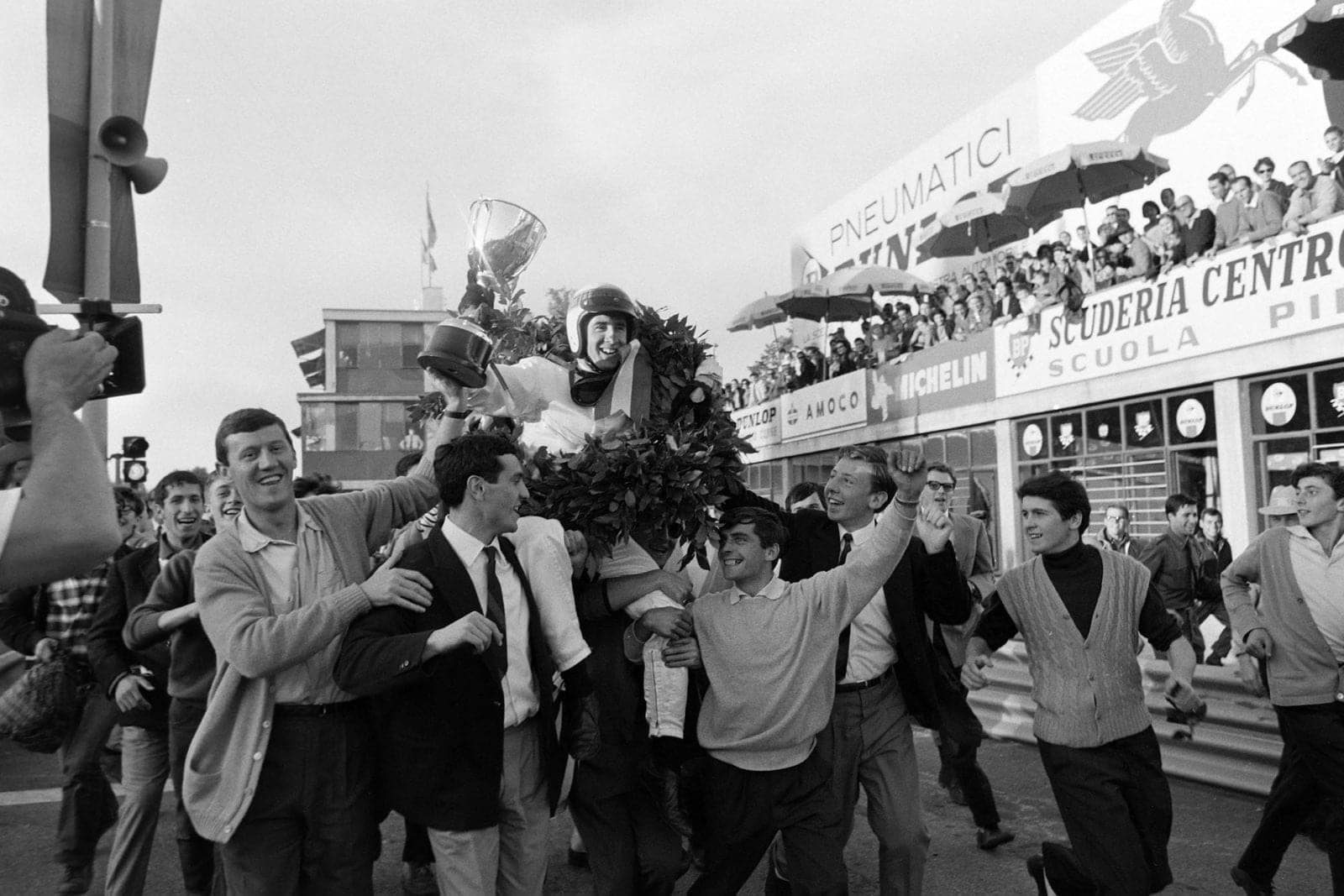
Stewart is hoisted aloft through the pit lane after taking his first F1 win
Motorsport Images
With no major Grand Prix race since the German Grand Prix at the beginning of August, the factory teams had plenty of time to prepare themselves for the annual high-speed race at Monza, on the 5.75-kilometre road circuit.
A very full entry was received and Lotus, Brabham, Ferrari and Centro-Sud fielded three-car teams, the Ferrari one actually being a four car team on paper, but three in reality.
From Maranello came three 12-cylinder Ferraris, numbers 0007 and 0008, that were at the Nurburgring, and 0009, a brand new one; and these were accompanied by 0006 which is the last of the V8 Ferraris. Surtees, Bandini and Scarfiotti were entered on the 12-cylinder cars, though the last-named did not appear and Surtees thus had two cars at his disposal. The 12-cylinder engines, had been improved with new cylinder heads having a different inlet-port angle, so that the long intakes, with Lucas fuel-injectors in them, were no longer vertical but inclined slightly outwards. Apart from improved brake calipers, as on the 12-cylinder cars, the V8 which Vaccarella drove was seemingly unchanged.
In the official entry list Surtees was entered under number 2, and Scarfiotti under number 8, but in both practice sessions Surtees drove both cars and made his fastest laps in number 8, which was the latest car.
Jack Brabham made arrangements with the Automobile Club of Milan for Baghetti to drive his car, and form the third member of the team, along with Hulme and Gurney, the American having a 32-valve Coventry-Climax V8 engine in his car. Similarly, Colin Chapman agreed to lend his third Lotus to the young F3 driver Giacomo Russo, who races under the pseudonym of “Geki”. Clark had Lotus R11, with 32-valve Coventry-Climax engine, Spence had R9, with a flat-crank 16-valve Climax engine, and “Geki” had old R6, with an early Climax V8 in it.
Although the BRM team had three cars with them they kept the third one as a spare for Graham Hill, who was driving 2516, while Stewart had 2517. The spare car was 2515, rebuilt after its crash at Clermont-Ferrand, and all three were using the latest type of V8 engine and had short exhaust pipes, finishing within the tail of the car, instead of the normal ones that protrude, this shortening presumably being in the interests of power at high rpm.
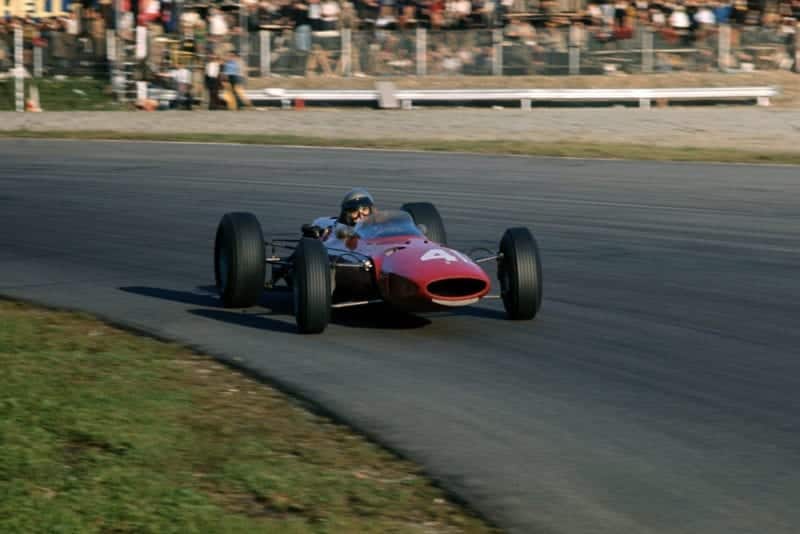
Bandini managed to qualify 7th
Motorsport Images
The Cooper team also had three cars, as they have used at previous races, the spare car having a Hewland gearbox instead of the heavy Cooper gearbox; McLaren and Rindt being the drivers.
Honda came with two cars and Bucknum was back as partner to Ginther, the two of them having spent a lot of time in Japan doing testing. The cars were basically the ones used all season but the engine/gearbox unit had been rotated forwards, about the rear mounting, and this allowed the engine part of the unit to be lowered some 2.5 to 3 inches, improving the handling enormously. This lowering of the engine only affected the car’s centre-of-gravity by a small amount, but on the modern GP car every inch counts.
Honda’s new engine position meant that the exhaust pipes from the front bank of cylinders could no longer run underneath the crankcase, and they were spread out on each side, around the crankcase, and then under the gearbox/final-drive unit, to join together into the lower tail-pipes. This tilting of the engine was such that the rear-most camshaft housing was now the highest point of the unit, and the air intakes pointed slightly forwards. The repositioning also meant some adjustments to the rear suspension, but the principle remained unchanged
Private teams made up the rest of the entry, Bonnier and Siffert with the Walker cars, Ireland and Attwood with the Parnell cars, Frank Gardner with the Willment Brabham, and Gregory, Bussinello and Giorgio Bassi with the Centro-Sud BRM cars. The only non-starters were Anderson, who did not consider it worthwhile rebuilding his Brabham-Climax after his crash at Nurburgring, and Raby who had sold his Brabham-BRM.
Qualifying
There was practice for three and a half hours on Friday and Saturday afternoons, which was more than enough, for the Monza circuit does not take much learning, engine power being all-important. On the first afternoon Surtees started off in car number 2, but the engine went sour and he switched to number 8, but there was no sign of Scarfiotti.
The Lotus team had all three cars out, but Spence and Clark both tried the third car, as well as driving their own cars, and “Geki” had to spend all afternoon standing around and never did get a drive.
Baghetti was more fortunate and drove the works Brabham, but did not seem to master the Hewland gearbox with its gate-less gear-lever. Gurney was in trouble with oil leaking out all over his 32-valve Climax engine, but Clark was fairly happy with his. However, it was Surtees who set the pace, in the newest flat-12-cylinder Ferrari, with a best time of 1min 37.0sec.
Bucknum’s Honda was going well and made third fastest time, only one-tenth of a second behind Clark, but Ginther’s Honda engine was off colour and would not give the power it was supposed to. Graham Hill and Stewart were well satisfied with their BRMs, and after everyone had been going round for an hour or more there was a long, pause and nobody seemed to want to go out.

Baghetti was entered in a third works Brabham
Motorsport Images
As there was 200,000 lire for FTD all the fast drivers sat back with the idea of having a serious go in the last half-hour. Unfortunately, while they were waiting it began to rain, and then a steady downpour set in for the rest of the afternoon, so fast lap times were out of the question and results were decided on the early part of the afternoon.
Gurney went out in the rain as the Brabham mechanics were still unable to sort out the oil leak, and in fact were still trying to locate its true source; Stewart also went out in the rain, to find out what it was like, this being his first visit to Monza. Apart from that, practice ended prematurely to all intents and purposes, and early darkness fell on a wet and gloomy paddock.
On Saturday Italy was back to normal and bright sunshine kept the track dry and speeds high. Throughout the afternoon there was a great deal of activity and everyone was circulating as hard as they could go; especially as there was another 200,000 lire for the fastest practice time, and 100,000 lire for the second fastest.
In addition to this it was a requirement that everyone should lap in a time no slower than 15% over that of the second fastest time. While this was not very arduous a requirement it did mean that as the top drivers got faster, the tail-enders had to speed up as well, and the harder the works drivers tried the harder the private-team drivers had to try.
The Honda team were in trouble, for Ginther’s engine broke something inside before he had done any laps, and Bucknum’s gearbox went wrong later in the afternoon, so that the Japanese mechanics had long hours of work ahead of them. Gurney’s oil leak could not be cured, and while he and Hulme were, circulating together Stewart came out of the pits, caught them, passed them, and went back into the pits again. Later he had a bit of a flurry with Surtees and outbraked him for the south turn each lap.
Graham Hill was doing an immense number of laps and trying all he knew, making quite fair lap times in the process, but they could not approach Stewart’s times, done with very little apparent effort. In the middle of the afternoon there was a concerted rush by a number of fast drivers and during this Clark did a fantastic time of 1min 35.9sec, compared with the 1964 lap record of 1min 38.8sec and the fastest practice lap in 1963 of 1min 37.3sec, both by Surtees with Ferraris.
“Graham Hill was doing an immense number of laps and trying all he knew but could not approach Stewart’s times”
Nobody else broke 1min 36sec, but Surtees and Stewart were in the 1min 36sec bracket. Surtees went out with Bandini and gave him a “tow” to try and improve his position on the grid, and Hulme endeavoured to do the same for Baghetti, slip-streaming at Monza being all important.
While the works drivers were out battling for the 200,000 lire the private team drivers took every opportunity to tuck in behind and profit from the superior speed of the works cars, Ireland, Attwood and Siffert making noticeable advances by this method. Conditions were ideal all afternoon and there was activity right up to 6:30pm, Graham Hill flogging round to the bitter end. The general tempo of the second afternoon had been such that everyone was well within the required qualifying time and all twenty-three cars were accepted for the start, even the inexperienced Bassi in the third of the Centro-Sud BRMs.
Race
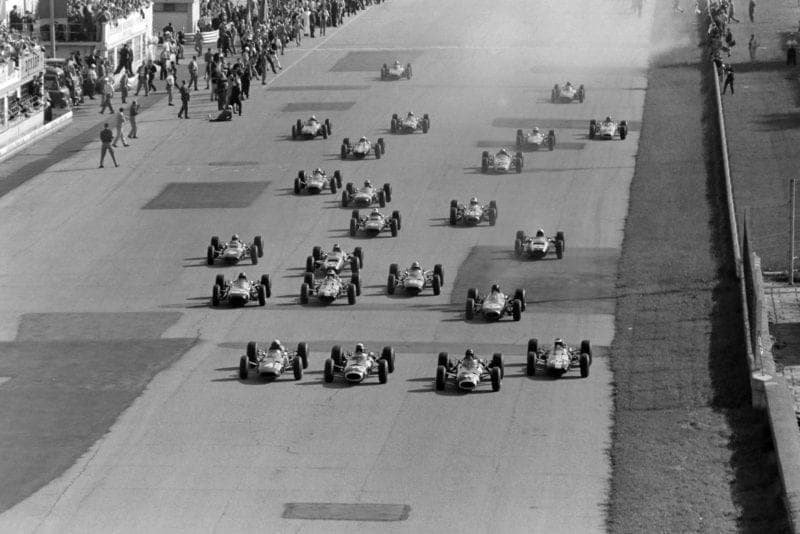
Ferrari’s Lorenzo battles with the BRMs of Stewart and Hill whilst Clark’s Lotus is edged out on the right
Motorsport Images
On Sunday morning the skies clouded and rain began, turning into a deluge that enveloped the Italian track, but by mid-day the rains had gone, the air cleared and the sun dried everything. Even the distant Alps could be seen quite clearly, a rare occurrence in September. The race was due to start at 3:30pm and run for 76 laps, a distance of 437 kilometres, and well before time the 23 competing cars were wheeled out on to the track.
The Lotus team were unchanged, Clark having the 32-valve Coventry-Climax engine, and “Geki” had practised on the Saturday afternoon with satisfying results. The Brabham team were not so happy as Gurney’s 32-valve engine could not be cured of its oil-leaking tendencies and it had been removed from Gurney’s car and an old engine substituted.
Surtees was using the latest of the 12-cylinder Ferraris, but as he went out to the starting grid the hydraulic mechanism of the clutch operation began to give trouble. The other Ferrari team drivers were in the cars used in practice, as were the BRM, drivers, but Rindt was driving the spare Cooper as his own car had broken a valve towards the end of practice.
After an all-night session the Honda mechanics had got both engine units reassembled, and they joined the others on the grid. The clutch operation on Surtees’ Ferrari appeared to have corrected itself and the whole field was lined up on the “dummy-grid”.
At the signal to move forward onto the proper starting grid all 23 cars were in order, with engines running and 1st gear engaged; a pause on the starting line for Clark, Surtees and Stewart in the front row, and then down went the Italian flag. Clark spun the Lotus wheels and made smoke like a dragster, and Surtees got away slowly, his clutch playing-up again, while Graham Hill did a meteoric start from the second row and shot between Clark and Surtees with inches to spare. The whole field made a magnificent sight and sound as they surged forward, the total of 200 tiny cylinders working away at peak power.
Everyone at the start waited eagerly while the scream of the exhausts disappeared towards the woods at Lesmo, and then they went singing down the back straight. Suddenly they were with us again, pouring out of the South Curve in a solid mass, with Clark and Stewart side-by-side, the Lotus a few inches in front of the BRM, but right behind came Hill, Bandini, Siffert, Spence, Gurney and the rest, with poor Surtees in 14th position, his clutch having slipped throughout the opening lap.
“The whole field made a magnificent sight and sound as they surged forward, the total of 200 tiny cylinders working away at peak power”
By the end of the second lap the field had divided into two groups, the first led by Clark, with Hill, Stewart, Bandini, Siffert, Spence and Gurney all in a collective slipstream, and the second group led by McLaren, with Ireland and Ginther inches behind, followed by the rest. Surtees was in this lot, but now the clutch had gone completely solid and he was changing gear without it, but at least he could start serious racing and in no time at all he left the second group and chased after the leaders.
Clark and the two BRM drivers were sharing the lead and Gurney was hanging on grimly, using their slip-stream to make up for his shortage of power. Bandini, Spence and Siffert were being sucked along, the Swiss driver haying done a skilful bit of manoeuvring on the opening lap to get in amongst the works drivers. Surtees made a remarkable recovery and by the sixth lap he was up with the leading group and working his way in amongst them.
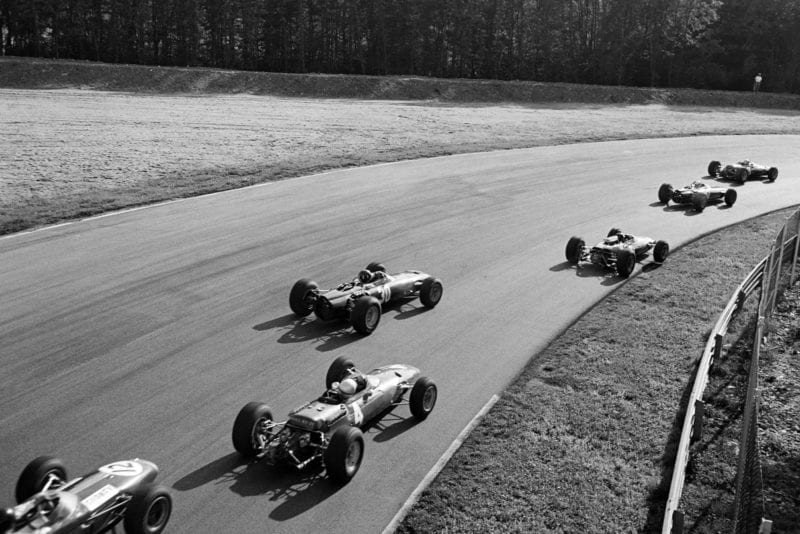
The pack fights through Curva Sud
Motorsport Images
The pace was more than Siffert or his car could be expected to keep up, and he began to slip back, but he was way ahead of all the other runners, who were still in a pretty solid bunch, the Parnell cars fighting it out with the works Coopers and Hondas. Clark and Stewart continued to share the lead, but even so Hill and Gurney were close enough to be touching all the time and Surtees was occasionally in between them.
With a clear track Surtees had caught the leading group with ease, they being busy fouling each other up, but once with them he could not hope to get away, for everyone was in everyone else’s slip-stream. At ten laps the situation was unchanged and Clark crossed the line mere inches ahead of Stewart, with Surtees third, and next lap the crowd shrieked with delight for the red nose of the Ferrari was actually in front of Stewart’s dark green BRM and Clark was now third.
However, by the time this fact had been noted the lead had changed once more and Stewart was in front again, where he stayed for the next six laps, but it was a precarious lead for the others were in a bunch all round him at times. Meanwhile the rest of the field were chopping and changing positions as much as the leaders, and Bucknum had his Honda at the head of the pack, with McLaren’s Cooper alongside.
Vaccarella, Bonnier and Gardner had lost contact with this group and were racing in a tight trio, and the Centro-Sud cars were bringing up the rear, though they were one short as Bassi had retired, soon to be followed by Baghetti, who was fumbling gear-changes and over-revving the engine of his Brabham until it broke. Bucknum’s Honda engine now showed signs of failing, no longer pulling maximum rpm down the back straight, and he pulled into the pits to investigate, and Ireland took command of the group, with “Geki ” right behind him.
This was still anybody’s race, just as was the leading group, and both Parnell cars were going splendidly, Attwood being in the thick of things. This group were urging themselves along at a higher rate than any of them would have gone on their own, with the result that they were slowly catching Siffert, who was completely on his own, having lost his “tow” from the works cars at the front of the race. Bucknum’s Honda did a few more laps but then returned to the pits and retired.
For lap after lap Stewart and Clark shared the lead, with Hill snatching it once or twice and Surtees ever present in second or third place, while Gurney and Bandini were obviously being towed along, and Spence began to drop back. For a time it looked as though the situation was becoming settled, with the two BRMs in front and Clark (Lotus) sitting just behind them while Surtees had dropped back a few yards and was with Gurney and Banditti. Even so the time interval covering this group of six cars was only one and a half seconds, and they were still in a tight bunch on the corners.
“For lap after lap Stewart and Clark shared the lead, with Hill snatching it once or twice and Surtees ever present in second or third place”
By thirty laps, which was not even halfway, there was no question of the issue being settled, though it was obvious that it lay between the two BRMs and the Lotus, for Gurney and the two Ferraris were now keeping up only by the grace of the slip-stream and the Ferrari of Surtees was beginning to show signs of weakening. At the back of the field Vaccarella, in the lone V8 Ferrari, was quite unable to get rid of Bonnier, in Walker’s Brabham-Climax V8, and Gardner in Willment’s Brabham-BRM V8, the three of them having a good race together.
At 33 laps the leaders caught up with this trio, to lap them, and there was a lot of dodging in and out, during which Clark went back into the lead. On the next lap, as Surtees passed the stands the Ferrari’s clutch slipped violently and the car slowed, to crawl round for the rest of the lap and retire at the pits. Clark and Stewart finished that lap side-by-side, as did Graham Hill and Gurney, but Bandini dropped back a bit, for having seen the other 12-cylinder Ferrari fall by the wayside he decided to settle for a finish in fifth position rather than risk a retirement.
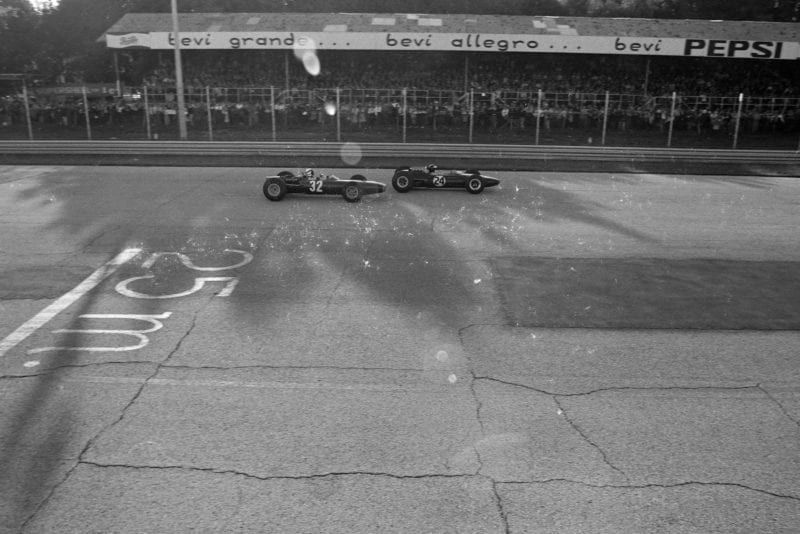
Stewart and Clark continued to trade places throughout the race
Motorsport Images
He had never been higher than fifth even at the height of the battle so he had nothing to lose and had no idea of what had gone wrong with his team-leader’s car. Spence was in sixth position and too far back to be any danger, so it was quite a wise decision that Bandini took. Gurney was still hanging on grimly, needing all the draught of the three cars in front of him to make up for his lack of horsepower, and this leading quartet were now in sight of lapping the mid-field mob.
Although they had caught Siffert there was no question of getting rid of him and sometimes Ireland had the lead, sometimes McLaren, and quite often Siffert, while Ginther, Attwood and Hulme were still in the thick of it, but Rindt had dropped back. As the leaders caught this lot, Sifferts gearbox broke and his fine run came to a sudden end, but the rest battled on and for a lap and a half the traffic was thick and heavy, with the slower cars tucking in behind the works cars to get a “tow.” Clark came out of this lot in the lead, but next lap Stewart was back in front and on lap 50 Graham Hill was in front.
Amidst all this fracas “Geki” had dropped out when his crown-wheel and pinion broke, due to all the oil leaking out of the final drive, Hulme retired his Brabham with deranged front suspension, and Gardner’s Brabham-BRM broke suddenly and he coasted into the side of the track. McLaren and Ireland were using Gurney’s slip-stream and unwittingly they caused him to lose contact with the leaders, for on his own he could only just hang on to the leading trio, but, with the Cooper and the Parnell Lotus worrying at his tail and distracting his attention and concentration he began to slow just sufficiently to lose the “draught” from the faster cars.
Clark led on two laps and then Hill led on two laps, but this was only as they crossed the finishing line, for the lead was changing all round the circuit. Then Clark led again and on lap 58 Stewart crossed the line first, with Hill and Clark in tow. McLaren and Ireland had caused Gurney to fall back quite a way to a distance of more than to seconds. For a few laps it looked as though stalemate had been achieved, with Clark following the two BRMs, all three nose-to-tail, or else Clark was having a “breather” before making his final attack.
It was quite obvious that he could not get away from the Bourne cars, and equally they could not get away from him, but the question was whether he could out-trick them or whether their team-driving could keep Clark back in third place to the finish. Scotsmen being the nationalistic race that they are, Graham Hill probably had fears that Clark and Stewart might put country before team and “fix” the Sassenach!
All down the field the pace was telling, and Ginther gave up when his Honda engine lost rpm, as well as having clutch trouble, and Vaccarella’s V8 Ferrari broke a valve and he did two complete laps before he realised it. On lap 63, as the leading trio crossed the line Clark was seen to have dropped back a little, and next time round the two BRMs were on their own. Clark had stopped on the far side of the circuit with trouble in the electrical system, which affected the fuel-injection pressure pump.
By a coincidence Spence ran into trouble at the same time, his alternator packing up and the ignition system failing through lack of amps. After a time they both got going again, to limp round to the pits and retire, and the BRM team were left in full command. Gurney was now third, 20sec in arrears, followed by Bandini 45sec farther back, the remainder having all been lapped.
Ireland was leading McLaren, they having lost contact with Gurney, and Attwood was a little way behind them, the two Parnell cars going as never before, but having just recorded that fact Ireland went by spluttering! He was getting low on fuel and the last few gallons were not feeding properly, and after a splendid race he had to ease right off and limp slowly round, hoping to finish.
The BRM triumph was magnificent, the two cars sounding perfect and all their rivals who had fallen by the wayside had to watch the two bottle-green cars circulate in close company, complete masters of the Italian Grand Prix. In the closing laps Graham Hill began to assert his number-one position and as they eased off slightly it was Hill who was crossing the line first, as was only right and proper.

After a race-long duel with his BRM team-mate Hill and Lotus’ Clark, Stewart emerged victorious
Motorsport Images
On lap 74 they virtually dead-heated across the line, but at the end of lap 75 Stewart appeared out of the south turn on his own! There was only just time to realise this before Hill appeared, and the two cars started their last lap, now some distance apart, instead of beside each other. Going into the south turn they had been together, with Hill on the outside, and he had moved out just a bit too far and got sideways on as his wheels hit the loose gravel on the track edge. He did not spin, as many people thought, but merely got “crossed up,” which made him lose contact with his young team-mate.
“On lap 74 they virtually dead-heated across the line, but at the end of lap 75 Stewart appeared out of the south turn on his own!”
Thus they finished, with Stewart really crowning his first Grand Prix season with a splendid victory, Graham Hill second, to hammer home the BRM victory, and a rather angry Dan Gurney third, 20sec in arrears. Angry because had he not got stuck with McLaren and Ireland when he lapped them he might have stayed with the BRMs to the finish, and taken second place when Hill made his error of judgement.
A very popular Bandini finished fourth, the only other driver not to be lapped, and five others followed him in, poor Ireland limping slowly round, unable to do anything about his trouble. According to the regulations, Clark, Spence, Vaccarella, Businello and Ginther were all classified as finishers, having completed more than 51 laps, even though they all retired.
